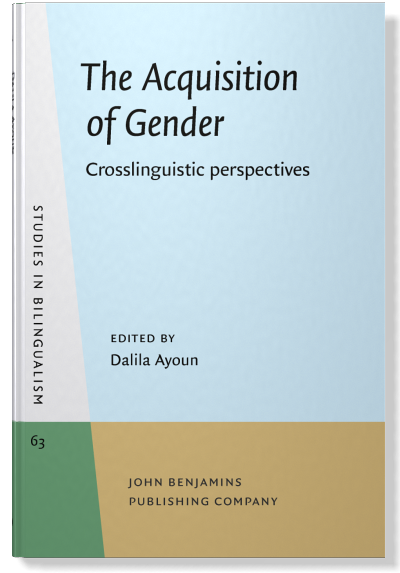
Ayoun, D. (2022)(Ed.). The Acquisition of Gender. Crosslinguistic perspectives. Amsterdam: John Benjamins. Gender as a morphosyntactic feature is arguably “an endlessly fascinating linguistic category” (Corbett 2014: 1). One may even say it is among “the most puzzling of the grammatical categories” (Corbett 1991: 1) that has raised probing questions from various theoretical and applied perspectives. Most languages display semantic and/or formal gender systems with various degrees of opacity and complexity, and even closely related languages present distinct differences, creating difficulties for second language learners. The first three chapters of this volume present critical reviews in three different areas – gender assignment in mixed noun phrases, subtle gentle biases and the gender acquisition in child and adult heritage speakers of Spanish – while the next six chapters present new empirical evidence in the acquisition of gender by bilingual children, adult L2/L3 learners and heritage speakers of various languages such as Italian, German, Dutch or Mandarin-Italian.
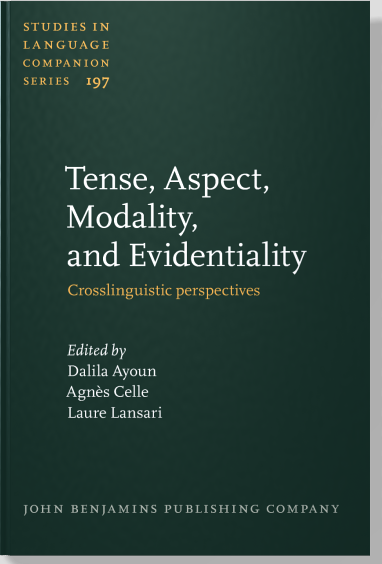
Ayoun, D., Celle, L. & Lansari, L. (2018)(Eds). Tense, Aspect, Modality and Evidentiality. Crosslinguistic Perspectives. . Amsterdam: John Benjamins. After an introductory chapter that provides an overview to theoretical issues in tense, aspect, modality and evidentiality, this volume presents a variety of original contributions that are firmly empirically-grounded based on elicited or corpus data, while adopting different theoretical frameworks. Thus, some chapters rely on large diachronic corpora and provide new qualitative insight on the evolution of TAM systems through quantitative methods, while others carry out a collostructional analysis of past-tensed verbs using inferential statistics to explore the lexical grammar of verbs. A common goal is to uncover semantic regularities and variation in the TAM systems of the languages under study by taking a close look at context. Such a fine-grained approach contributes to our understanding of the TAM systems from a typological perspective. The focus on well-known Indo-European languages (e.g. French, German, English, Spanish), but also on less commonly studied languages (e.g. Hungarian, Estonian, Avar, Andi, Tagalog) provides a valuable cross-linguistic perspective.
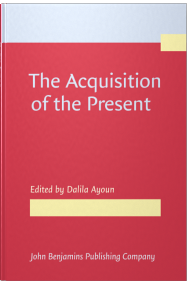
Ayoun, D. (2015)(Ed.). The Acquisition of Present. Amsterdam: John Benjamins. The objective of the present volume is to contribute to the already impressive body of research in TAM from a variety of theoretical perspectives by delving into the L1 and L2 acquisition of the present. The first two chapters focus on the L1 acquisition of English with the analysis of longitudinal data from the perspective of the Aspect hypothesis and the Verb-Island hypothesis (Wang & Shirai), and the L1 acquisition of French from the perspective of the zero-tense hypothesis (Demirdache & Lungu). The remaining chapters tackle the L2 acquisition of English (Liszka, Al-Thubaiti, Vraciu), French (Ayoun, Saillard), Spanish (Gabriele et al.), Russian (Martelle) and Japanese (Li & Shirai) with different L1 background (French, English, Arabic, Chinese and Korean) testing various semantic and syntactic hypotheses. The last chapter summarizes the findings of these studies, and offers a few conclusions and directions for future research.
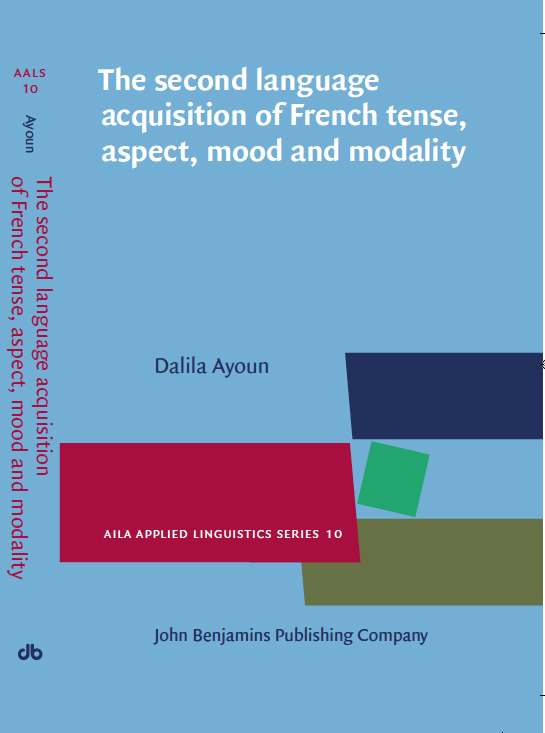
Ayoun, D. (2013). The Second Language Acquisition of French Tense, Aspect, Mood and Modality. Amsterdam: John Benjamins. Temporal-aspectual systems have a great potential of informing our understanding of the developing competence of second language learners. So far, the vast majority of empirical studies investigating L2 acquisition have largely focused on past temporality, neglecting the acquisition of the expression of the present and future temporalities with rare exceptions (aside from ESL learners), leaving unanswered the question of how the investigation of different types of temporality may inform our understanding of the acquisition of temporal, aspectual and mood systems as a whole. This monograph addresses this question by focusing on three main objectives: (a) to contribute to the already impressive body of research in the L2 acquisition of tense, aspect and mood/modality from a generative perspective, and in so doing, to present a more complete picture of the processes of L2 acquisition in general; (b) to bridge the gap between linguistic theory and L2 acquisition; (c) to make empirical findings more accessible to language instructors by proposing concrete pedagogical applications.

Ayoun, D. (2008)(Ed.). Studies in French Applied Linguistics. Amsterdam: John Benjamins. Studies in French Applied Linguistics invites the reader to adopt a broad perspective on applied linguistics, illustrating the multifaceted work researchers are conducting in so many various, inter-connected subfields. The five chapters of the first part are dedicated to the first and second language acquisition of French in various contexts: first language acquisition by normal children from a generative perspective and by children with Specific Language Impairment; second language acquisition in immersion settings, from a neurological approach to phonology and natural language processing and CALL. The six chapters of the second part explore the contribution of French in various subfields of applied linguistics such as an anthropological approach to literacy issues in Guadeloupean Kreyol, literacy issues in new technologies, phonological and lexical innovations in the banlieues, French in North Africa, language planning and policy in Quebec, as well as the emerging field of forensic linguistics from an historical perspective.

Ayoun, D. (2007)(Ed.). French Applied Linguistics. Amsterdam: John Benjamins.This state-of-the-art volume on French Applied Linguistics includes two introductory chapters, the first summarizes the past, present and future of French in applied linguistics, and the second reviews the history of French from a sociolinguistic perspective. The six chapters of the first part cover the core aspects of the second language acquisition of French: Phonology, semantics/syntax, syntax/morphology, pragmatics, sociolinguistics, and grammatical gender. The seven chapters of the second part explore the contribution of French in various subfields of applied linguistics such as language ideology and foreign language pedagogy, corpus linguistics, and French Sign Language. A chapter studies the role of affective variables on language learning, while another investigates natural language and lexical creativity. The chapters on creole studies and applied linguistics in West Africa address issues in first and second language acquisition in complex sociolinguistic and political contexts. The last chapter serves as an epilogue focusing on Louisiana, a region rich in linguistic history.
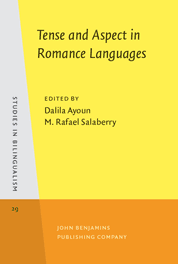
Ayoun, D. & Salaberry, R. (2005)(Eds.). Tense and Aspect in Romance Languages: Theoretical and Applied Perspectives. Amsterdam: John Benjamins.This volume presents a state-of-the-art descriptive and explanatory analysis of the second language development of Romance tense-aspect systems. It contains new experimental data from adult French, Catalan, Portuguese learners, and Italian children learners. Standing research questions are addressed and pedagogical implications for foreign language classrooms are proposed arguing that there are possible commonalities in the instructional sequences of tense-aspect development in Romance languages. The first chapter presents an overview of current theoretical approaches and a summary of empirical findings. The following four chapters introduce new empirical data from a variety of theoretical perspectives (e.g., the Aspect Hypothesis, the UG/Minimalist framework). Chapter 5 proposes practical pedagogical approaches for the foreign language classroom based on empirical findings. The last chapter summarizes and discusses these findings in order to start elaborating a more comprehensive model of the development of tense-aspect marking in the Romance languages.
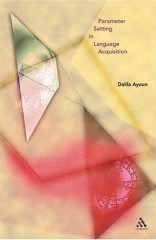
Ayoun, D. (2003). Parameter-setting in Language Acquisition. London: Continuum Press.
This book provides a broad overview of parameter-setting theory in first and second language acquisition and refines the theory by revisiting and challenging the traditional assumptions that underlie it, based on cross-linguistic language data that cover a range of syntactic and phonological phenomena. From an historical perspective on parameter-setting theory to an introduction to its role in computational linguistics, neurolinguistics, and language change, the reader will find a critique of the most commonly made arguments, as well as an index of all the syntactic, phonological, lexical, and morphological parameters presented in the literature to date. A closer look at the theory itself addresses the following questions: What does a parameter-setting approach to language acquisition entail? What are the underpinnings of the theory? What issues and problems remain to be solved? The empirical studies carried out to test the null subject parameter and verb movement parameter are reviewed to re-examine long-standing theoretical assumptions as well as the learnability implications for first and second language acquisition.